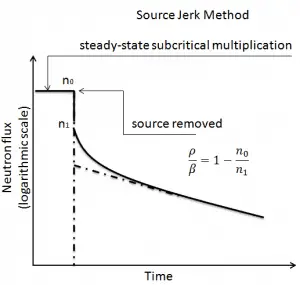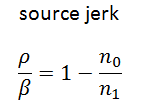 The source jerk method belongs to a group of source perturbation methods. But in principle, the source jerk method is essentially the same as the rod drop method, except that it is a subcritical measurement, and the neutron source is removed instead of inserting a control rod. This method is based on the study of the transient response of the reactor to a rapid neutron source removal from a reactor.
The source jerk method belongs to a group of source perturbation methods. But in principle, the source jerk method is essentially the same as the rod drop method, except that it is a subcritical measurement, and the neutron source is removed instead of inserting a control rod. This method is based on the study of the transient response of the reactor to a rapid neutron source removal from a reactor.
In this case, the subcriticality of the reactor (subcritical multiplication) can be determined from the measurement of the prompt drop. Also, here the prompt drop can be measured because the delayed neutron precursor population will not change immediately. Following sudden source removal, the neutron population undergoes a sharp negative jump.
As was described in the Prompt Jump Approximation, the response of a neutron detector (n1 ➝ n2) immediately after a source removal from a subcritical reactor (ρ1 < 0) is related by:
where n0 is the neutron level with the source in place and n1 is the neutron level immediately after the source jerk. Since a source is much smaller and lighter than a control rod, it is easier to quickly remove it from the core. On the other hand, in commercial reactors, this method cannot be used because, in commercial reactors, neutron sources (when used) cannot be simply removed from the core. Moreover, commercial reactors contain high burnup fuel, which is an important source of neutrons.
See also: Source Neutrons
